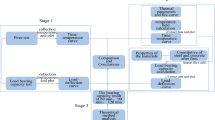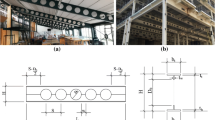Abstract
Prestressed continuous composite beams (PCCBs) have been widely used in constructions. While the open literature contains notable works that examine the behavior of PCCBs at ambient conditions, the behavior of these members at elevated temperatures has rarely been addressed. As such, this paper focuses on investigating fire resistance of PCCBs by means of advanced numerical simulation. For this purpose, a finite element model was developed to predict the fire response of PCCBs and this model was validated through utilizing actual observations from newly conducted fire tests. Furthermore, a series of parametric studies were carried out to investigate the effect of key parameters on fire response of PCCBs. These parameters include magnitude of applied load, prestressing level, size of external tendons and ratio of span to depth of cross section. The outcome of this parametric study shows that the load ratio has an adverse influence on the fire resistance of PCCBs. For instance, the greater the magnitude of applied loading was, the slower the transient prestress in the external tendons decreased with increasing temperature, and the lower the critical temperature was. Further, when temperature was below 375°C, the larger the prestress ratio was, the slower the deflection increasing rate was. Calculated sagging moment capacity gradually decreased with the temperature rise, reaching the minimum at 150°C, then the moment increased with the increase of temperature. Meanwhile, hogging moment at middle support increased with the increase of temperature during the initial heating phase, then gradually decreased with increasing temperature. For PCCBs with different span-to-depth ratios, the difference of critical temperatures was negligible when the load ratio was constant, and their deflections were very close. When the ratio of span to depth was > 10, the effect of span-to-depth ratios on behavior of PCCBs can be ignored.













Similar content being viewed by others
References
Ranzi G, Leoni G, Zandonini R (2013) State of the art on the time-dependent behaviour of composite steel–concrete structures. J Constr Steel Res 80:252–263
He J, Liu Y, Chen A, Wang D, Yoda T (2014) Bending behavior of concrete-encased composite I-girder with corrugated steel web. Thin-Walled Struct 74:70–84
Graczykowski C, Orlowska A, Holnicki-Szulc J (2016) Prestressed composite structures—modeling, manufacturing, design. Compos Struct 151:172–182
Derkowski W, Skalski P (2017) New concept of slimfloor with prestressed composite beams. Proc Eng 193:176–183
Kambal MEM, Jia Y (2018) Theoretical and experimental study on flexural behavior of prestressed steel plate girders. J Constr Steel Res 142:5–16
Ren Y, Wang Y, Wang B, Ban H, Song J, Su G (2018) Flexural behavior of steel deep beams prestressed with externally unbonded straight multi-tendons. Thin-Walled Struct 131:519–530
Chen S (2005) Experimental study of prestressed steel–concrete composite beams with external tendons for negative moments. J Constr Steel Res 61:1613–1630
Chen S, Jia Y (2010) Numerical investigation of inelastic buckling of steel–concrete composite beams prestressed with external tendons. Thin-Walled Struct 48:233–242
Dall’Asta A, Dezi L, Leoni G (1999) Long term analysis of externally prestressed composite beams. In: Chan SL, Teng JG (Eds.) Advances in steel structures (ICASS ‘99). Elsevier, Oxford, pp 931–938
Ding Y, Jiang K, Liu Y (2012) Nonlinear analysis for PC box-girder with corrugated steel webs under pure torsion. Thin-Walled Struct 51:167–173
Bisby LA, Kodur VKR (2007) Evaluating the fire endurance of concrete slabs reinforced with FRP bars: considerations for a holistic approach. Compos B Eng 38:547–558
Mukherjee A, Rai GL (2009) Performance of reinforced concrete beams externally prestressed with fiber composites. Constr Build Mater 23:822–828
Si-Larbi A, Agbossou A, Ferrier E, Michel L (2012) Strengthening RC beams with composite fiber cement plate reinforced by prestressed FRP rods: experimental and numerical analysis. Compos Struct 94:830–838
Balsamo A, Nardone F, Iovinella I, Ceroni F, Pecce M (2013) Flexural strengthening of concrete beams with EB-FRP, SRP and SRCM: experimental investigation. Compos B Eng 46:91–101
Peng F, Xue W (2018) Design approach for flexural capacity of concrete T-beams with bonded prestressed and nonprestressed FRP reinforcements. Compos Struct 204:333–341
Seręga S, Kotynia R, Lasek K (2018) Numerical modelling of preloaded RC beams strengthened with prestressed CFRP laminates. Eng Struct 176:917–934
Wang X, Zhou C (2018) Numerical investigation for the flexural strengthening of reinforced concrete beams with external prestressed HFRP sheets. Constr Build Mater 189:804–815
Zhou H, Li S, Chen L, Zhang C (2018) Fire tests on composite steel-concrete beams prestressed with external tendons. J Constr Steel Res 143:62–71
Chen S, Gu P (2005) Load carrying capacity of composite beams prestressed with external tendons under positive moment. J Constr Steel Res 61:515–530
Moreira LS, Sousa JBM, Parente E (2018) Nonlinear finite element simulation of unbonded prestressed concrete beams. Eng Struct 170:167–177
Xie J, Zhao X, Yan J-B (2018) Experimental and numerical studies on bonded prestressed concrete beams at low temperatures. Constr Build Mater 188:101–118
Zhu H, Wu G, Zhang L, Zhang J, Hui D (2014) Experimental study on the fire resistance of RC beams strengthened with near-surface-mounted high-Tg BFRP bars. Compos B Eng 60:680–687
Zhang W-F (2018) Symmetric and antisymmetric lateral–torsional buckling of prestressed steel I-beams. Thin-Walled Struct 122:463–479
Eurocode 3: design of steel structures—part 1–2: general rules—structural fire design, British Standards (2005)
Eurocode 4: design of composite steel and concrete structures—part 1–2: general rules—structural fire design, British Standards. (2005)
Zhou HT, Li GQ, Jiang SC (2008) Experimental studies on the properties of steel strand at elevated temperatures. J Sichuan Univ 5:106–110 (In Chinese)
Chen LZ, Li GQ, Jiang SC (2013) Experimental studies on behavior of headed stud shear connectors at elevated temperatures. J Tongji Univ 41:1151–1157 (In Chinese).
ABAQUS (2010) Analysis user’s manual 6.10-EF. Dassault Systems Simulia Corp., Providence, RI
Acknowledgements
Funding was provided by National Natural Science Foundation of China (Grant No. 51878528) and the Fundamental Research Funds for the Central Universities (Grant No. cqu2018CDHB1B02).
Author information
Authors and Affiliations
Corresponding author
Additional information
Publisher's Note
Springer Nature remains neutral with regard to jurisdictional claims in published maps and institutional affiliations.
Rights and permissions
About this article
Cite this article
Zhou, H., Hao, C., Zheng, Z. et al. Numerical Studies on Fire Resistance of Prestressed Continuous Steel–Concrete Composite Beams. Fire Technol 56, 993–1011 (2020). https://doi.org/10.1007/s10694-019-00916-7
Received:
Accepted:
Published:
Issue Date:
DOI: https://doi.org/10.1007/s10694-019-00916-7




